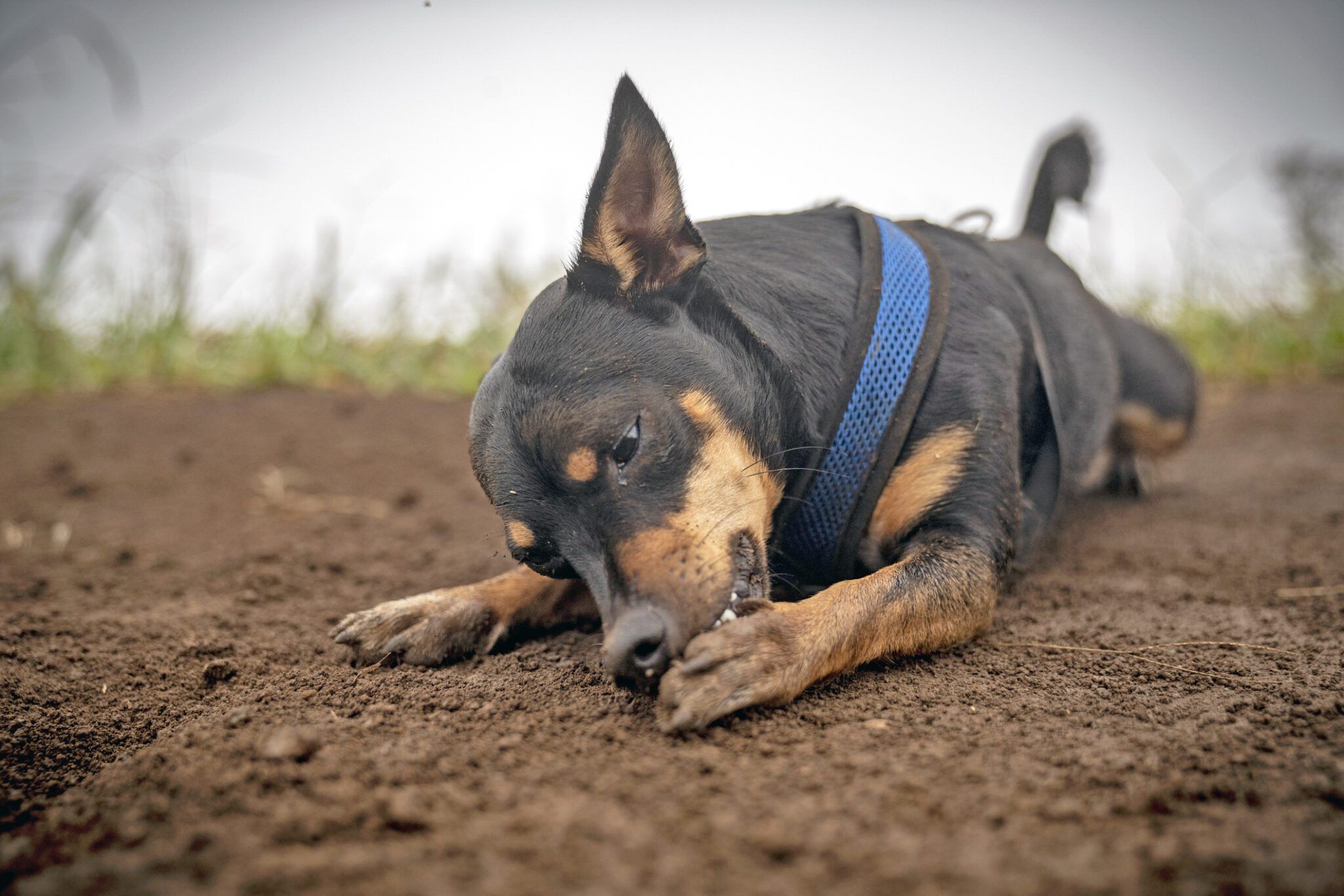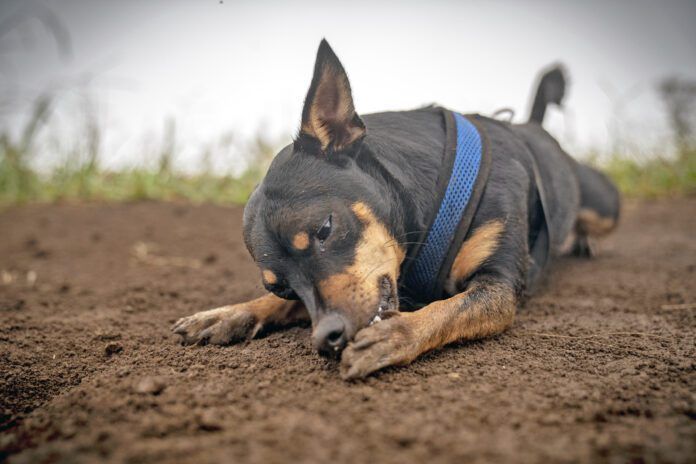Proper care of your dog’s nails and following treatment instructions for any injuries can help keep your dog on the run and allow problems to heal faster. If you and your dog participate in dog sports requiring speed, injuries are more likely, and 19% of those injuries occur in the paw or claw.
Some dog paw problems focus around the dog’s nails, or claws. Note: A dog’s nails are technically “claws” because they are pointed, curved, and grow out of the end of an appendage. Nails are flatter and more rounded and grow over the end of the appendage. We will use both terms in this piece, however, because “dog nails” is the more common term.
Unhealthy Dog Nails
Regular trimming of your dog’s nails can prevent some problems and promote normal body stance and movement.
- Overgrown claws. If your dog’s claws are too long, they change the way he stands and walks. Ideally, your dog’s nails should be short and close to the paw, so that they can be used to grip when needed but don’t get in the way the rest of the time. Some dogs wear their claws down naturally, but many require weekly nail trims to obtain ideal nail length.
- Broken claws. If your dog catches her nail on something, it can break. If the break occurs in the keratinized portion of the claw, it will not hurt. But if it affects the “quick,” which has blood vessels and nerves in it, it will both hurt and bleed. Broken claws are more likely to occur if your dog has long claws that are not trimmed regularly. In some cases, you may be able to trim the broken claw yourself, but if it is bleeding or painful you may need a veterinary appointment for removal under sedation.
- Ingrown claws. Untrimmed claws continue to grow and may eventually curl under and into the paw. This is painful, and the resulting wound is susceptible to infection. If your dog’s nails tend to curl (we’re looking at you, Pugs and Beagles), keep on top of regular nail trims. An ingrown claw will require a vet appointment to potentially trim the nail and clean the wound under sedation, plus prescribe antibiotics to resolve any infection that may be present.
- Infected claws. Dog nails can become infected by yeast or bacteria. You may notice that your dog’s paws smell weird, and that the texture of the claws has changed. Infected nails may appear bloody, greasy, discolored, or feel soft when you try to trim them.
- Symmetrical lupoid onychodystrophy (SLO). This is an autoimmune disease that causes inflammation of the claw bed, which in turn leads to abnormal claws. Dogs with SLO often have sore, painful paws, and the claws frequently fall off and grow back with an abnormal shape or texture. This condition will require long-term medications and management to keep your dog comfortable.
Unhealthy Dog Paws
Claw problems aren’t the only things that may go wrong with your dog’s feet. Some potential dog-paw problems include:
- Run off pads. Active dogs who like to run over hard surfaces such as asphalt, cement, rocks, or hard-packed dirt can damage the thick pads on the bottom of their paws. The friction between the paw and the ground causes the pad layer to separate from the sensitive underlying tissues. While this is not a dire situation, it is painful. Your dog will need to rest while the weak spots in the pad(s) heal and may need pain meds or antibiotics from your veterinarian.
- Longhaired dogs seem to love to get things stuck in the hair between their toes, which can cause uncomfortable knots to develop. Carefully clip existing mats to relieve discomfort. Prevent future mats by keeping the hair on your dog’s feet trimmed.
- Yeast and bacterial infections. Dog paws can be an ideal spot for microbial infections. Common signs include a characteristic “corn chip” odor, oozy or flakey skin on the paws, and licking or chewing. Your veterinarian will do a skin scrape to determine the cause of the infection and treat it with appropriate topical or systemic medications.
- Dogs with allergies—especially environmental allergies—often get itchy feet. You will notice your dog constantly licking and chewing his paws, and the characteristic dark rusty staining of the hair from all the licking. Some dogs may feel better with just Benadryl, but many may need prescription meds such as Apoquel, Cytopoint, or allergy injections to quell the itch. Some dogs have seasonal allergies, while others experience symptoms year-round.
- Paw lacerations. A cut paw hurts! Your dog will limp, and bleeding may seem excessive because of the many blood vessels in the paw. Initiate first aid by applying pressure to stop bleeding, then call your veterinarian to get the wound cleaned and some antibiotics.
- Broken toes. Dogs can break their toes in many ways, even by getting a toe stuck in a crate door or by being stepped on. Most of these fractures can heal on their own with strict rest. If the bone heals poorly or continues to bother your dog, amputation may be the best choice. Dogs do fine with a missing toe or two.
- Sarcoptic mange. The mites that cause sarcoptic mange like to live in dogs’ skin, and they cause an extreme itch along with red, irritated skin. Your vet can check for mange with the same skin scrape that checks for bacterial and fungal infections. Thankfully, sarcoptic mange can be treated with many of the same medications that we use to prevent fleas and ticks.
- Keratin overgrowth. While most common in brachycephalic breeds such as Boxers or Bulldogs, some dogs have excessive growth of the hard keratin on their paw pads. Instead of being smooth with a slight cobblestone pattern, these dogs have long thin projections all over the paw pads. This condition is not usually painful but can impact how your dog walks. Excess keratin can be trimmed back by your veterinarian.
- Interdigital furunculosis. This condition is most common in short-haired breeds such as Bulldogs and may be referred to as interdigital cysts, although the bumps are not true cysts. Interdigital furunculosis is when the hair follicles on the paw become inflamed, resulting in painful swelling on or between the toes. This condition is often related to allergies, and it can predispose the dog to deep bacterial infections in the paw that require long treatment courses with antibiotics.
- Pemphigus foliaceus. This is an autoimmune disease that causes crusts, sores, and severe irritation on the paws. Dogs with pemphigus foliaceus may also have secondary yeast or bacterial infections, which make their paws even more uncomfortable. Your veterinarian will treat any infections directly and address the pemphigus with an immunosuppressive medication.
- Squamous cell carcinoma and melanoma are two common cancers that can develop on dogs’ paws. If you notice a growth on your dog’s paw—especially if it is growing rapidly—schedule a veterinary appointment as soon as possible.
Bottom Line
Truly unhealthy dog paws and unhealthy dog claws are not common, but they can be painful. Set your dog up for success by trimming his claws regularly and checking his paws any time you notice lameness or excessive licking and chewing.

